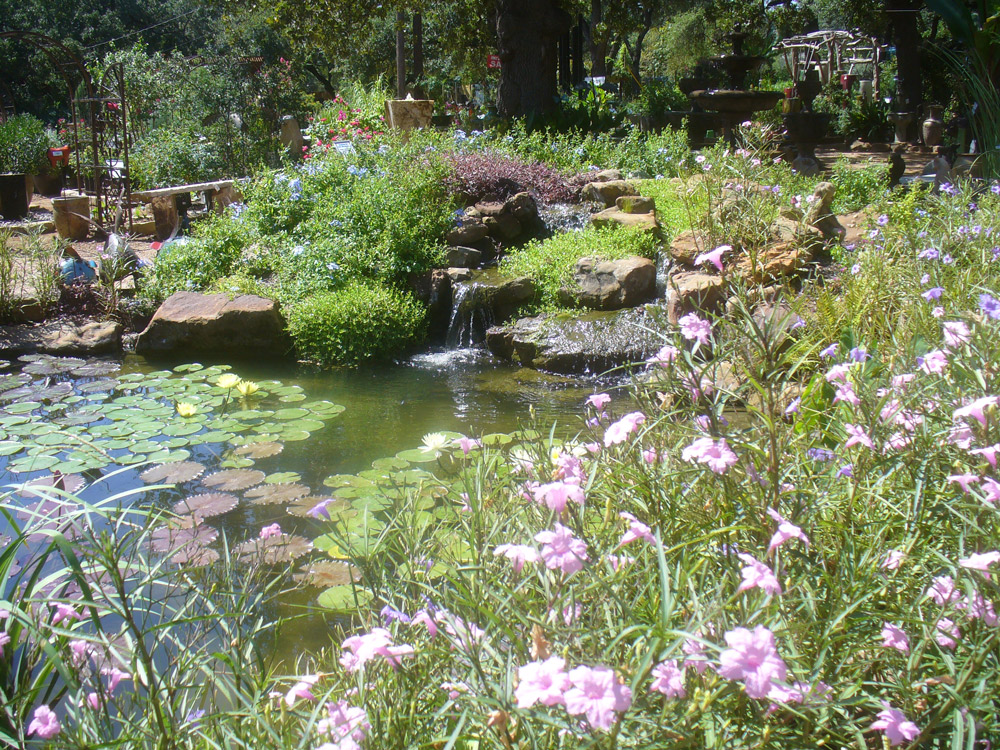Natural Filtration 301 Chapter 5
The Next Step, Active Bog Filtraion
Most ornamental ponds have a pump for circulation. The more circulation around the roots the better Phytofiltration works. Add these two observations together and you’ll come up with Active Bog Filtration, where the water from a Skimmer, a UV or directly from the pond is pumped into a gravel bed filled with plants. Why bother? Because Active Filtration “supercharges” nutrient uptake by the ornamental plants in the bog, completely removing the nutrients that would otherwise nurture algae. It’s not just that the moving water carries more nutrients within the reach of roots in any given time period. It’s not just that the pressure behind pumped water pushes more readily into every space that roots occupy. It’s also a result of the generally higher dissolved oxygen level in vigorously circulated water. Higher DO levels vastly increase the metabolic rate of the bacteria that convert nitrite to nitrate, and the nitrate is produced at a greater rate right on and around the roots that absorb it. I wish I could prove that Active Bog Filtration effectively doubles the uptake of nutrients, but I can’t. I can tell you that it takes only half as much bog filter area to achieve the same results with Active as with Passive Filtration. By moving water through the gravel in an Active Perimeter Bog, for example, you can effectively increase the rate of absorption of nutrients to equal or exceed that of planted rafts, which are very efficient because the roots are actually suspended in the water column. You can even increase the efficiency of planted rafts, by making them “active”. Use air diffusers directly beneath planted rafts to bubble up oxygen and sediments into the root masses below the islands – and step back, Jack! The rate and quantity of plant growth is astonishing.
Active Bog Filters come in a couple of flavors and two directions, Upflow and Downflow. The most common Active Filters are planted streams, where water flows over and around the plants in a shallow streambed or pool. Next are the Upflow Bogs, where water is forced upwards through a planted gravel bed. Active Perimeter Bogs and Active Bog Islands fall into this category. Finally, there are Downflow Bogs, which we’ll talk about in this section but are really not Bog Filters at all, since they are not planted and do not remove nutrients, although they certainly help with ammonia conversion. Rather, they function as large prefilters to capture sediment and keep pumps from clogging.

Most ornamental ponds have a pump for circulation. The more circulation around the roots the better Phytofiltration works. Add these two observations together and you’ll come up with Active Bog Filtration, where the water from a Skimmer, a UV or directly from the pond is pumped into a gravel bed filled with plants. Why bother? Because Active Filtration “supercharges” nutrient uptake by the ornamental plants in the bog, completely removing the nutrients that would otherwise nurture algae. It’s not just that the moving water carries more nutrients within the reach of roots in any given time period. It’s not just that the pressure behind pumped water pushes more readily into every space that roots occupy. It’s also a result of the generally higher dissolved oxygen level in vigorously circulated water. Higher DO levels vastly increase the metabolic rate of the bacteria that convert nitrite to nitrate, and the nitrate is produced at a greater rate right on and around the roots that absorb it. I wish I could prove that Active Bog Filtration effectively doubles the uptake of nutrients, but I can’t. I can tell you that it takes only half as much bog filter area to achieve the same results with Active as with Passive Filtration. By moving water through the gravel in an Active Perimeter Bog, for example, you can effectively increase the rate of absorption of nutrients to equal or exceed that of planted rafts, which are very efficient because the roots are actually suspended in the water column. You can even increase the efficiency of planted rafts, by making them “active”. Use air diffusers directly beneath planted rafts to bubble up oxygen and sediments into the root masses below the islands – and step back, Jack! The rate and quantity of plant growth is astonishing.
Active Bog Filters come in a couple of flavors and two directions, Upflow and Downflow. The most common Active Filters are planted streams, where water flows over and around the plants in a shallow streambed or pool. Next are the Upflow Bogs, where water is forced upwards through a planted gravel bed. Active Perimeter Bogs and Active Bog Islands fall into this category. Finally, there are Downflow Bogs, which we’ll talk about in this section but are really not Bog Filters at all, since they are not planted and do not remove nutrients, although they certainly help with ammonia conversion. Rather, they function as large prefilters to capture sediment and keep pumps from clogging.





